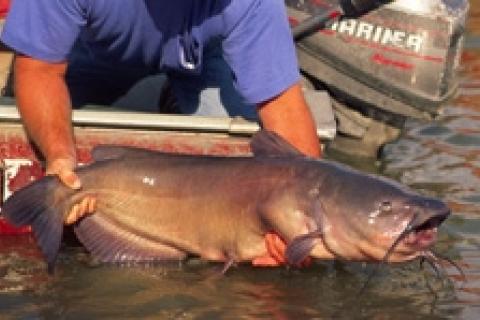
 |
| Fish, worms, crawdads, liver, and reeking confections of blood and guts are blue-plate specials for catfish. |
Some folks will tell you that fishing for the largemouth bass, with its hit 'em hard, tail-walking fighting style, is our finest sportfish. Others believe it's the colorful, acrobatic trout, the good-things-come-in-small-packages bluegill, the scrappy crappie or numerous other gamefishes, each of which holds a special attraction for its own group of fanatical devotees. For seven million anglers, however, the undisputed monarch of all polebenders is the catfish.
Catfishing isn't a flashy sport. You don't need a fancy boat or magforce powerbuster rods. High-tech reels and Volkswagen-sized suitcases full of pretty lures aren't necessary.
Fish, worms, crawdads, liver and reeking confections of blood and guts are the blue-plate specials for catfish. Inexpensive tackle can replace the snazzy gear, and you catch cats from the bank as easily as from a boat.
Glamorous? Hardly. But don't be misled. When you hook a catfish, you better hold on. This customer is tough, mean, feisty and smart to boot. Smash 'em, bash 'em, bang 'em up: that's the catfish's game.
Want to hook a true lunker? A fish over 25 pounds, say? Then catfishing better be on your angling itinerary. A few other fish are caught over 20 pounds, but not regularly. If I were an oddsmaker, I'd lay 3-to-1 odds on big cats, and 100-to-1 on all other lunkers. Catfish may be the best table fish of all. And more importantly, catfish occur in stupendous numbers in wide spectrum of waters throughout the U.S. Many blue-ribbon catfish waters are almost untouched by catfish anglers and their offerings.
The Catfish Family of Players
There are four major members of the catfish family in North America: the flathead catfish, blue cat, channel cat and bullhead.
The flathead frequents large rivers, bayous and reservoirs. It's incredibly ugly-pot-bellied, wide-headed and beady-eyed, but what it lacks in good looks, it makes up for in size. Most will average 3-10 pounds, but 25-50 pounders aren't rare, and flatheads up to 123 pounds have been caught on rod and reel.
The blue catfish rivals the flathead in size and can weigh nearly 120 pounds. It, too, prefers the sanctuary of larger rivers and reservoirs, and, like the channel cat, is usually caught over bottoms of rock, gravel or sand.
The channel catfish resembles the blue but seldom grows larger than 15 pounds. The world record, a real giant, tipped the scales at 58. Channel cats love streams and rivers, but millions are produced at fish hatcheries each year and stocked in lakes and ponds as well.
Bullheads are found throughout much of the U.S. Because of their small size (they seldom exceed two or three pounds) many anglers don't target them. But in some Midwestern states such as Iowa, they're the number one sportfish. Many anglers caught the catfishing bug while fishing for bullheads as a child.
Rods and Reels
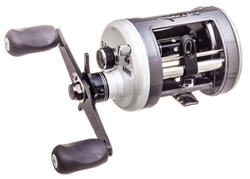 |
| Baitcasting reels provide a lot of power for cranking in big fish. |
Catfishermen probably use a wider variety of rods and reels than any group of sport fishermen, everything from tiny spinning outfits that fit under a car seat to super-long surf-casting rods with enormous reels.
If you spend most of your time dabbling for bullheads, an ultralight spinning outfit works great. If channel cats are your quarry, and you fish waters where 5- to 10-pounders sometimes surface, a 6-foot, medium-action bass-fishing combo may be the ticket to satisfaction. If you're hoping to bring in one of the 100-pounders lurking somewhere out there, better go equipped with a heavy-action baitcasting rig constructed with the sturdiest materials.
This is common sense shopping, really. Look at the options available, then buy the best combination you can afford for the conditions and catfish you usually encounter.
Bait-casting, Spinning or Spincast Reels?
Baitcasting reels provide more power for cranking in big fish. The best models hold at least 200 yards of 17- to 20-pound monofilament. Good ones also feature a "clicker" mechanism that gives an audible signal when line is pulled from the reel, thus indicating that a catfish is taking your bait. The clicker also keeps a soft, steady tension on the spool, thereby preventing a cat from backlashing the reel when it runs with a bait.
Spinning reels have a place in catfishing, too, although they don't offer the raw power or line-pick-up speed that baitcasters provide. Their primary application is when fishing light line (anything less than 12- to 14-pound-test). They handle smaller-diameter lines better, and if you want to have a good time catching cats, and won't be too upset if a monster snaps your line, traditional bass-fishing models work fine.
Spincast reels are still the traditional favorites of many catfish fans. None has the winching power or line capacity of a large baitcaster, but each offers simple push-button casting control with a soft delivery suitable for small baits. This type of reel is perfect for children learning to cast, but don't expect one to hold up well when battling a hard-fighting trophy-class catfish.
Fishing Line
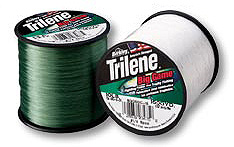 |
| When hunting the big boys, you may have to upgrade 30-, 40-, even 80- pound test. |
Catfish aren't line-shy, so you can use light or heavy fishing line as situations dictate. High-strength, small-diameter monofilaments testing 15 to 25 pounds are good inexpensive choices for all-round use, but when hunting the big boys, you may have to upgrade to 30-, 40-, even 80-pound-test. When fishing rock-strewn tailraces, riprapped banks and heavy wood cover, you need strong line that resists abrasion. In these situations, braided lines may be best.
Fishing Hooks
There are two primary considerations when selecting a hook for catfishing — size and style.
Always use the smallest hook feasible. Small hooks penetrate quicker than big hooks. Smaller hooks also allow better bait presentations.
Small does not mean thin, however. The thin-wire hooks often used by panfishermen will straighten out when connected to even a modest-size catfish. Use heavy-gauge designs sturdy enough to hold the fish you're targeting.
Match the size of the hook to the type and size of bait. Bear in mind that the hook point should remain well exposed after impaling the bait. A too-small hook may set back into the bait on the hookset, failing to make the desired connection.
When fishing small baits for small catfish, you may need nothing larger than a No. 2 to No. 1 fish hook. A 1/0 or 2/0 hook is good when presenting a small strip of thin cutbait, but a 3/0 or 4/0 may be required when cutbait is prepared in thick chunks. A 5/0 or 6/0 is necessary when using bluegills and other live baitfish up to six inches. Switch to even larger hooks when using baits in the one-pound class to entice trophy-size cats.
Most catfishermen carry several different hook designs in their tackle box. Styles often used for live-bait and cutbait fishing include Sproat, O'Shaughnessy, Round Bend or Viking, Faultless, Kirby, Kahle and Octopus. The O'Shaughnessy, an old-time favorite of many catters, is an excellent, sturdy, multi-purpose hook available in sizes up to 10/0. The Kahle hook is another favorite. Its wide-gap design provides plenty of room for a large live or cutbait.
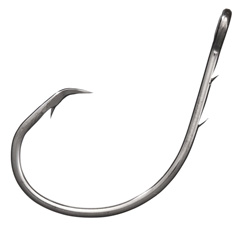 |
| Circle hooks are designed to quickly penetrate a cat's mouth as it stuggles against the tension of the line. |
Another style, the circle hook, is popular with catfish anglers. Circle hooks are designed to quickly penetrate a cat's mouth as it struggles against the tension of the line. Most cats get hooked in the corner of the mouth, not deep in the gullet where the hook may not penetrate properly in bony structures. For this reason, cats are more likely to stay hooked during the heat of battle, and they can be released with little or no harm.
Fishing Sinkers
Fishing sinkers serve primarily to carry bait down to a water level where catfish are feeding. Choice depends primarily on the type of rig being fished, water depth, current velocity and bottom conditions. Use a size that has just enough weight to keep your bait in place at the desired level in the water column.
Slip sinkers like the Lindy No-Snagg Slip Sinkers slide freely on your line, usually above a barrel swivel or split shot used as a stop. Commonly used examples include egg sinkers, bullet sinkers and walking slip sinkers.
Other sinker designs commonly used by cat men include bell, bank, pyramid and bottom-bouncer sinkers.
Split shot are versatile and convenient for light-tackle fishing when small amounts of weight are needed. They also are used to balance sliding floats, weight drift rigs and as make-shift sinker stops on bottom rigs.
 |
| Premium Balsa Slip Floats |
Fishing Bobbers & Floats
Bobbers, or floats, add weight so it's easier to cast small baits like night crawlers and catalpa worms. They keep your bait moving efficiently into areas catfish inhabit. And because they move along a distinct path, you know exactly where your bait is and something about what it's doing. You won't get snagged as often using a bobber, you'll know when a fish is biting, and you can suspend just above the bottom where many catfish feed.
Catfishermen use two basic types of bobbers-fixed bobbers, which attach firmly to the line, and sliding, or slip, floats like the Bass Pro Shop Premium Balsa Slip Floats that move freely along the line.
Fixed bobbers are best suited for fishing waters no deeper than the length of your rod or pole. This style of float allows the bait to remain at a preset depth after casting.
In deeper water, or when casting long distances, use a sliding bobber to eliminate casting problems caused by the long length of line between the bobber and the hook. These bobbers slide up and down the line, and your entire rigging (bobber, sinker and hook) can be reeled almost to the rod tip. When cast, the bobber floats while the sinker pulls the line through the bobber. A bobber stop or stop knot placed on the line stops line movement and suspends the bait at the preferred depth.
Adding Swivels to Your Fishing Rigs
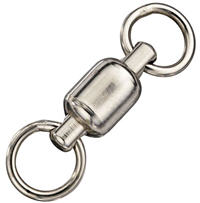 |
| With catfishing, use top-quality ball-bearing swivels. |
Because catfish tend to twist and roll when hooked (as do many live baits used for catfishing), many fishermen like to add a swivel to their rigs. Swivels also serve as "stops" between slip sinkers and hooks.
If you do use swivels, avoid cheap brass-plated models. Instead, use top-quality ball-bearing swivels. The extra expense could mean the difference between landing a trophy or losing one.
![]() Tip: A great way to save money and stock up on the most popular sizes of swivels at the same time. Try the Bass Pro Shops® 50-Piece Ball Bearing Swivel Assortment
Tip: A great way to save money and stock up on the most popular sizes of swivels at the same time. Try the Bass Pro Shops® 50-Piece Ball Bearing Swivel Assortment
Fishing Accessories
Additional fishing gear you might want to consider buying for catfishing include:
- Rod holders, for boat and bank
- A sturdy landing net
- Fisherman's pliers or pliers like the popular Bass Pro Shops Aluminum Pliers or fishing multi-tool
- A good tackle box or tackle bag
- Marker buoys like the Bass Pro Shops Marker Buoys that also come with a rack: to mark dropoffs, bottom channels, humps, holes, etc.
- Lanterns, flashlights or headlamps and lantern accessories: for night fishing
- Insect repellent
- Anchor(s) for your boat for your boat
- A lawn or camp chair or stool for bank fishing
- A cooler(s) for carrying food, drinks, bait or catfish
- Life vests or jackets: for safety
- Polarized sunglasses: for cutting glare on the water
- Rod bells: clip to your rod tip to signal strikes
- Electronic strike indicators or "bite alarms": produce an audible signal when a catfish bites
- Cutting board like the Bass Pro Shops Deluxe Cutting Board and fillet knives: for preparing baits like cut fish
Basic Fish Bait Choices
Big flatheads prefer live fish (minnows, small sunfish, shad, etc.) hooked to remain lively.
Big blue catfish most often are taken on oily baitfish such as shad and herring that have been cut into chunks or fillets.
Channel catfish, bullheads, small blues and small flatheads will eat almost anything. Live crawdads, minnows, night crawlers, shad, catalpa worms, salamanders, insects (especially grasshoppers), frogs, leeches. Almost anything dead such as: chicken liver, mussels, shrimp, shad, frogs. Weird stuff like Tender Chunks dog food, marshmallows, hot dogs and Ivory soap. Malodorous brews of cheese, decayed meat, blood and viscera; stuff that could honestly gag a maggot, indeed throw in the maggots for good measure. And at times jigs and crankbaits.
- 121653 views

